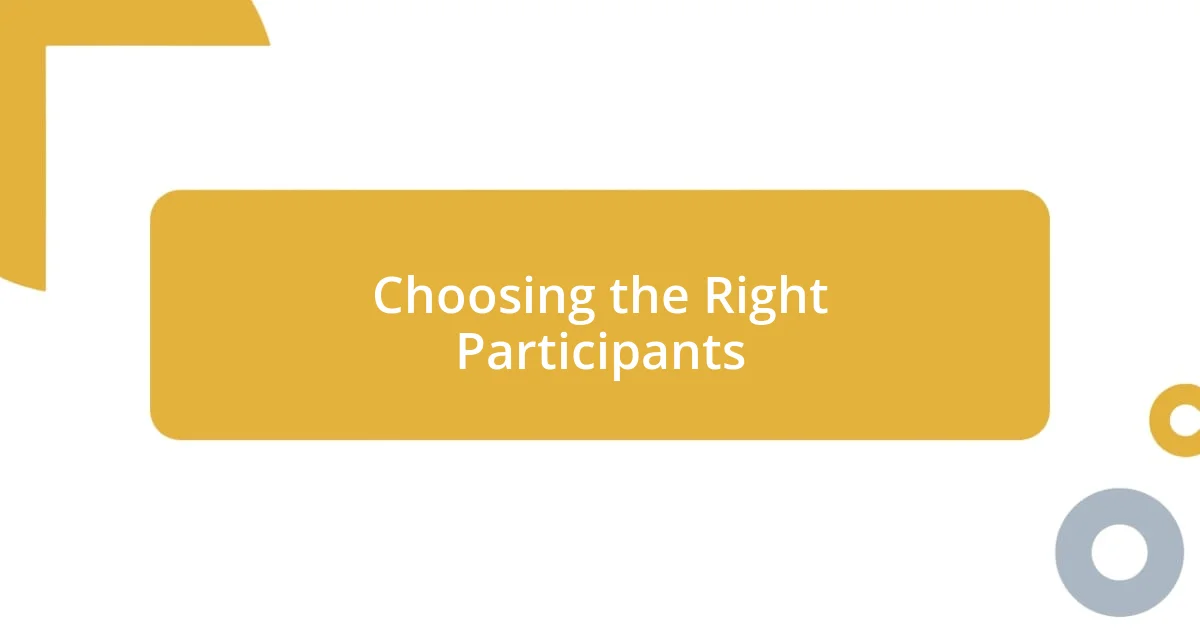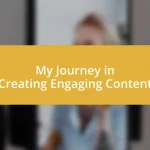Key takeaways:
- Reader-centric focus groups reveal the emotional connections and life experiences that influence reading preferences, allowing for a deeper understanding of the audience.
- Effective focus group organization includes selecting diverse participants, fostering open discussions, and utilizing active listening techniques to enhance engagement and insight.
- Implementing feedback and creating a feedback loop fosters collaboration, leading to more relatable content and deeper participant investment in the creative process.

Understanding Reader-Centric Focus Groups
Reader-centric focus groups are all about understanding the audience’s needs, preferences, and motivations. I remember a session where participants expressed their strong emotional connections to specific genres. It was eye-opening to see how deeply their personal stories influenced their reading choices. Have you ever thought about how your experiences shape what you want to read?
The magic of these focus groups lies in the diversity of perspectives. I was struck by how one participant unexpectedly shared her struggle with mental health and how that influenced her taste in books. The way she described it made me realize that our life experiences often guide our literary journeys. Isn’t it fascinating how a simple conversation can uncover such profound insights about what draws us to certain narratives?
By creating a safe space for dialogue, we invite readers to express themselves freely. I noticed that when people felt comfortable, their feedback became richer and more authentic. They didn’t just tell us what they liked; they revealed why it mattered to them. This connection creates a powerful tool for content creators to tailor their work more effectively. Wouldn’t you agree that knowing your audience on a deeper level can transform the way we approach storytelling?

Steps to Organize Focus Groups
Organizing focus groups requires meticulous planning to ensure you capture valuable insights from participants. From my experience, it’s crucial to start with a clear objective. For instance, I once focused a session on young adult literature preferences, which allowed us to tailor our content more specifically. Here’s a streamlined approach I often rely on:
- Define the purpose of the focus group.
- Choose a diverse group of participants that represents your target audience.
- Develop open-ended questions to foster discussion.
- Schedule and set up a comfortable environment for the meeting.
- Collect and analyze feedback systematically.
Once the participants are on board, creating a welcoming atmosphere is vital. I remember conducting a group in a café, where the relaxed setting prompted more natural conversations. When participants feel at ease, their stories can flow more freely. And it’s those unique, unscripted moments that often provide the richest insights. Consider this checklist for a successful environment:
- Warmly welcome participants and introduce yourself.
- Encourage everyone to share, fostering respectful dialogue.
- Use open body language to show engagement.
- Include some icebreakers to loosen up the group.
- Close with a thank you and reiterate the importance of their input.

Choosing the Right Participants
When selecting participants for reader-centric focus groups, it’s essential to prioritize diversity. I recall an experience where we included a mix of ages, backgrounds, and reading preferences. This blend helped us uncover insights we wouldn’t have considered otherwise. For instance, a retired teacher brought historical novels into the conversation, while a college student championed contemporary fiction. These different viewpoints shaped our understanding of genre preferences.
It’s also important to select participants who are genuinely interested in the topics being discussed. During one of my focus sessions, I made the mistake of including participants who were indifferent to the genre. Their lack of enthusiasm diluted the conversation. I learned that those who are passionate about what they read provide deeper, more engaging insights. Wouldn’t you agree that a participant’s energy can significantly influence the overall discussion?
Lastly, I believe in the power of creating an environment where participants feel valued. Once, I invited a participant who was a writer herself. She shared her struggles and triumphs in getting published, which inadvertently opened conversations about genre expectations. Her willingness to be vulnerable made others comfortable, allowing for rich, authentic discussions about their own experiences. By thoughtfully choosing participants, you enhance the quality of feedback, which ultimately leads to more compelling content.
| Selection Criteria | Description |
|---|---|
| Diversity | Include a mix of ages, backgrounds, and genres to capture a range of perspectives. |
| Interest Level | Select participants who are genuinely passionate about the subject matter. |
| Value and Comfort | Create an environment where participants feel respected and valued. |

Techniques for Effective Discussions
Effective discussions in focus groups hinge on the art of asking the right questions. Open-ended inquiries, like “What types of books resonate with you emotionally?” can elicit deeper responses compared to simple yes or no questions. I once posed a question about the impact of character development in a book, and it sparked an hour-long debate among participants—such a wealth of insight emerged from their stories!
Another technique I cherish is the power of active listening. While facilitating a session, I find that truly listening not only demonstrates my respect for participants’ viewpoints but also encourages them to open up further. I remember a particular moment when a participant shared a personal story about a life-changing book. The other members became more engaged, sharing their connections to that narrative. Isn’t it fascinating how one vulnerable moment can create a ripple effect in group dynamics?
Lastly, encouraging thoughtful pauses can significantly enhance the quality of conversation. In my experience, allowing a few seconds of silence after a question often leads to richer responses. I used to rush in to fill the gaps, but I quickly learned that those moments allowed participants to reflect. It’s interesting how silence can sometimes be the loudest part of a conversation, isn’t it? When participants feel they have space to think, the discussions often become deeper and more meaningful.

Analyzing Feedback for Insights
Analyzing feedback can sometimes feel overwhelming, but I find it incredibly rewarding. After one group session, I carefully sifted through their comments and discovered a pattern. Participants repeatedly highlighted the importance of relatable characters. This insight resonated with me because I remember feeling a similar connection when reading a book that mirrored my own experiences. It made me wonder: how often are we missing these powerful connections in our content?
One particular time, I utilized a simple but effective method: thematic coding. By categorizing feedback into themes like “emotional impact” and “plot relevance,” I was able to see emerging trends. This process was a lightbulb moment for me. As I connected the dots, the feedback transformed into actionable insights that I could apply to my writing. I asked myself how many other great ideas might be hidden within the noise of participant comments if we take the time to dig deeper.
Reflecting on the nuances of the feedback, I made it a point to share my findings with the group. During the next session, I presented their shared insights back to them. I watched as faces lit up with recognition and agreement, fueling even more vibrant discussions. It brought home the idea that analyzing feedback isn’t just about numbers—it’s about understanding the emotions and experiences underlying those words. Isn’t it fascinating how analyzing feedback brings everyone closer together, creating a shared understanding?

Implementing Changes Based on Feedback
Implementing changes based on feedback can be transformative for both the facilitator and the participants. I recall a focus group where the feedback pointed toward a need for stronger endings in our stories. After mulling it over, I decided to revamp the last chapter of my upcoming book, leaning into the emotional impact that participants craved. The satisfaction of knowing I was crafting a narrative that resonated with readers felt incredibly fulfilling, almost like a collaborative effort in itself.
During the following sessions, I shared the revised chapters with the group and their reactions were priceless. Some participants leaned in, eyes wide with acknowledgment as they recognized their input had influenced my work. That moment made me realize how powerful it is to show participants the new direction taken based on their insights. Don’t you think it’s encouraging for everyone when they see their voices reflected in tangible changes?
Moreover, I learned the importance of setting up a feedback loop. Not only did I implement participant suggestions, but I regularly checked in during sessions to discuss how their feedback played a role in my writing journey. This ongoing dialogue fostered a deeper trust and investment from them. It was gratifying to watch participants become more enthusiastic, knowing they were part of a creative process, and for me, each meeting became an opportunity to initiate positive change. It’s amazing how nurturing this relationship can lead to richer, more textured storytelling.












